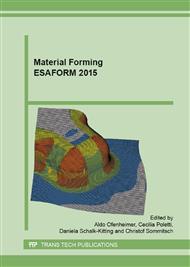p.71
p.77
p.83
p.89
p.96
p.102
p.108
p.114
p.120
Predictive Performances of FLC Using Marciniak-Kuczynski Model and Modified Maximum Force Criterion
Abstract:
This paper is focused on the performance evaluation of two theoretical models that can be used to predict the Forming Limit Curve (FLC) for an AA6016-T4 aluminium alloy sheet. The FLC is calculated based on the Marciniak-Kuczynski (M-K) model and the Modified Maximum Force Criterion (MMFC) using the Hill '48, Barlat '89 and BBC 2005 yield criteria, the latter identified in three variants, namely with 6, 7, and 8 material parameters. The performance assessment of the M-K and MMFC models combined with different yield functions is based on the comparison between the theoretical predictions and the experimental data provided by the Nakazima test (ISO 12004: 2008) as well as by an experimental procedure recently developed by the authors for the FLC determination.
Info:
Periodical:
Pages:
96-101
Citation:
Online since:
July 2015
Authors:
Keywords:
Price:
Сopyright:
© 2015 Trans Tech Publications Ltd. All Rights Reserved
Share:
Citation:


